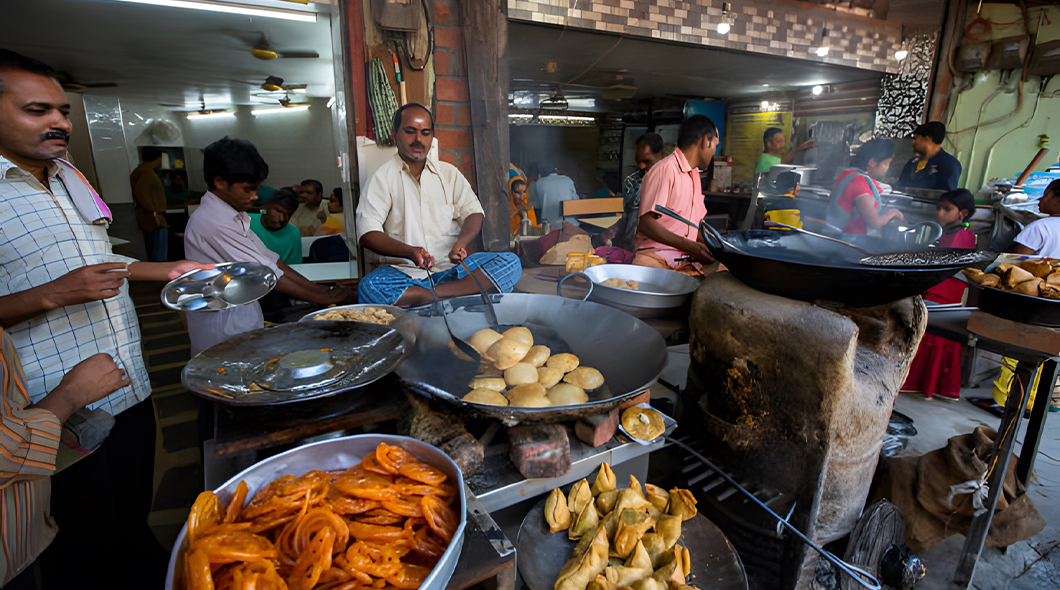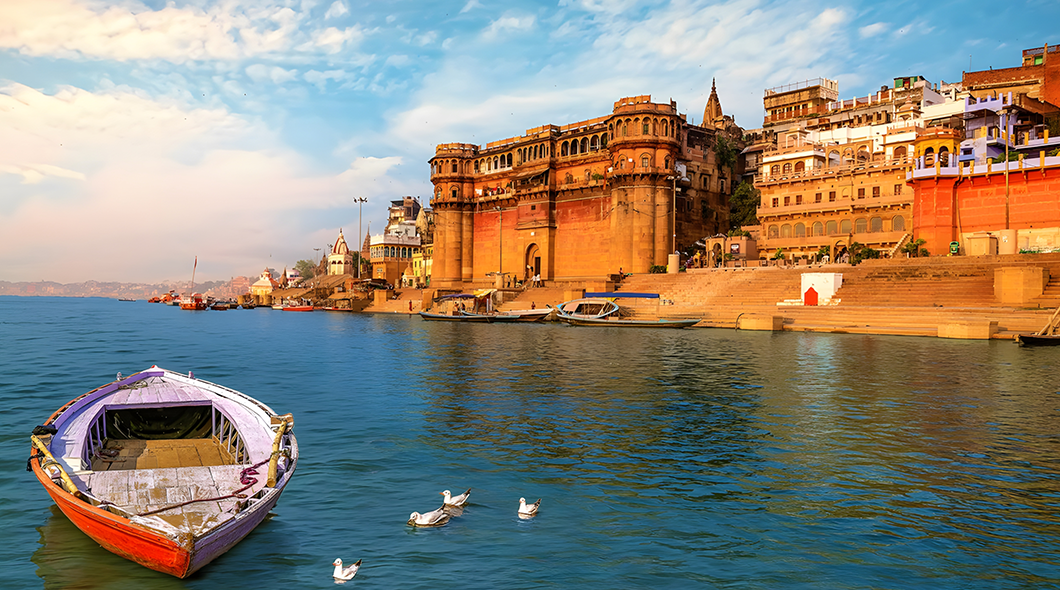To call Kolkata a city of paradoxes would be an understatement. At one place, it buzzes with the energy of noisy trams, taxis, and markets that stretch endlessly, but the other Kolkata is quiet – best seen at its riverfronts and public parks. And the best example that emanates this quality of the city is its Kali mandirs. Sometimes quiet, while at other times bustling with devotion and divinity, the Kali Mandirs in Kolkata capture the city’s soul. Even the city (theoretically) derives its name from the word Kalikkhetro (Bengali for Adyashakti Kali), meaning the “area of Goddess Kali” which later became Kolikata.
So, it would be equivalent to a sin to go to Kolkata and leave the city’s Kali Mandirs out of your itinerary. And to help you avoid that sin, IamNavigato has made a rough and ready list of some famous as well as lesser-known Kali Mata Mandirs in Kolkata.
10 Kali Mandirs in Kolkata You Must Visit Once
Kolkata, to say the least, is dotted with temples dedicated to Kali, numbering around thousands. But you don’t necessarily need to visit each and every one of them. Here are ten Kali Mata Temples in Kolkata to experience the grace of Maa Kali herself.
| Sr. no. | 10 Kali Mandirs in Kolkata | Location |
| 1 | Kalighat Kali Temple | Anami Sangha, Kalighat, Kolkata – 700026 |
| 2 | Dakshineshwar Kali Mandir | Dakshineswar, Kolkata – 700035 |
| 3 | Lake Kalibari | 107, Sree Sree 108 Karunamoyee Kalimata Mandir, 1, Southern Ave, Rabindra Sarobar, Ballygunge, Kolkata – 700029 |
| 4 | Chinese Kali Mandir | G9VV+Q26, 41, Matheswartala Road, Tangra, Kolkata, West Bengal 700046 |
| 5 | Dakat Kali Bari | 9/1A, 39/1A, Purna Das Rd, Triangular Park, Lake Terrace, Gariahat, Kolkata – 700029 |
| 6 | Thanthania Kali Bari | Bidhan Sarani, Rajendra Deb Ln, College Street Market, College Street, Kolkata – 700006 |
| 7 | Boro Maa Kali Temple | Shyam Rd, Thakur Para, Naihati, Kolkata – 743165 |
| 8 | Firingi Kalibari | 244, Bepin Behari Ganguly St, Calcutta Medical College, Bowbazar, Kolkata – 700012 |
| 9 | Sri Sri Nistarini Devi Kali Mandir | Bethune Row, Hedua, Kolkata – 700006 |
| 10 | Sri Sri Karunamoyee Kali Mandir | 32, Mahatma Gandhi Rd, Haridevpur, Paschim Putiary, Kolkata – 700082 |
1. Kalighat Kali Temple
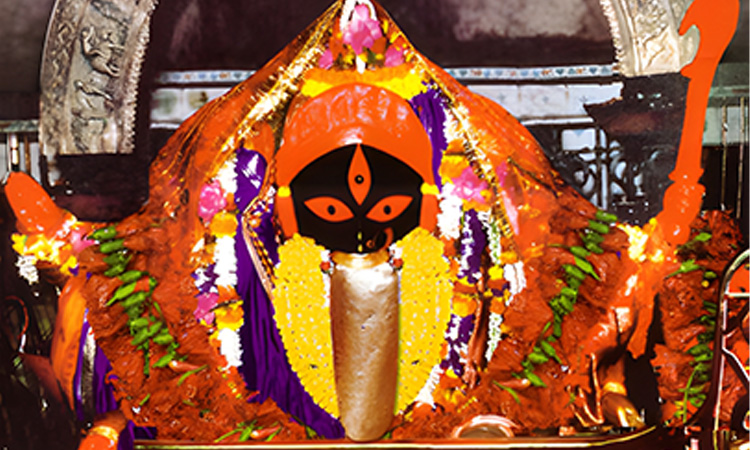
Perhaps the most famous Kali temple in Kolkata, as well as the whole world, the Kalighat Kali Temple offers an experience that you will never forget. Known as one of the 51 Shakti Peeths, it draws devotees and travelers alike. Step in and expect to be blown away by the striking 19th-century architecture, complete with floral and peacock-motif tiles that look equally entrancing at day or night.
An interesting story is linked to the mandir’s conception. It is said that a man named Atma Ram fell over a stone resembling human toes in the Bhagirathi River and was struck by divine revelation. He recognized the stone as the toes of Goddess Sati and built the temple to commemorate both the stone relic and a Swyambhu Lingam of Nakuleshwar Bhairav (a form of Lord Shiva).
But the highlight of this Maa Kali temple in Kolkata is easily its main idol. Powerful, breathtaking, and soul-stirring – all at the same time, it’s carved out of sandstone with three blaring eyes, four sacred hands, and a protruding tongue made of gold.
Timings: 5 am–2 pm & 5–10:30 pm
2. Dakshineshwar Kali Mandir
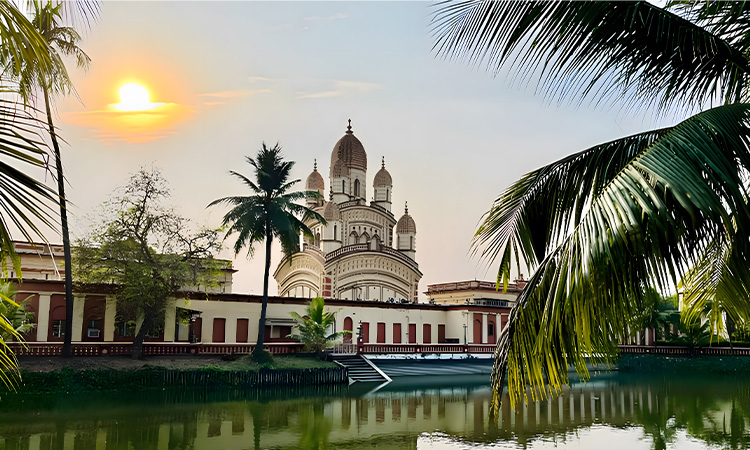
No list of Kali Mata Mandir in Kolkata is complete without the Dakshineshwar Kali Mandir. It is perched on the banks of the Hooghly River with a cream-and-red complex that never fails to inspire with its architectural brilliance. Here, detailed carvings, grand domes, soaring spires, vibrant motifs, and sculptures portraying stories from Hindu mythology come together to create a sight that is sure to remain with you.
As the story goes, it was the famed Bengal Queen, Rani Rashmoni, who sanctioned this Kali Mata Temple in Kolkata. It is said that the inspiration came to her in a dream from the Goddess herself. Today, you can find people of all religions, creeds, castes, and sects praying at this temple.
Timings: 6 am–12:30 pm & 3:30–7:30 pm
3. Lake Kalibari
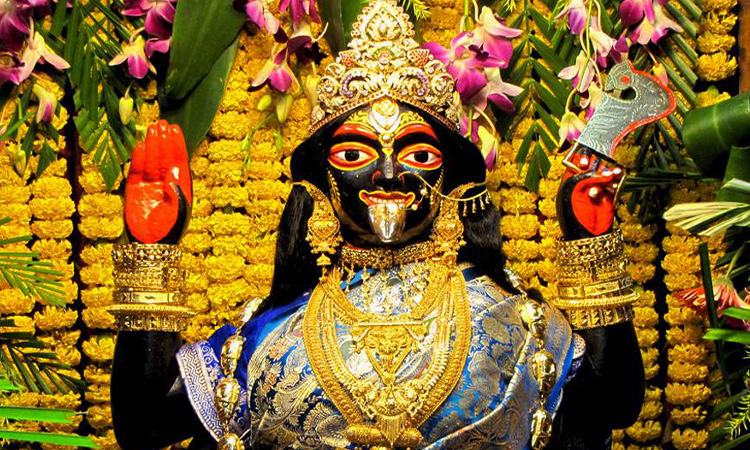
This small Kali Mandir in Kolkata attracts millions of visitors daily. Why? The place is said to offer a calm and peaceful environment. People flock to seek the blessing of the goddess, bringing family, kids, and even new bikes or cars.
The origin of this mandir mirrors that of the famed Dakshineshwar Kali Temple. Haripada Chakraborty, fondly known as Gurudev, is said to have received a swapnadesh (divine command in a dream) from Maa Kali herself. When he confessed his lack of resources, the Goddess reassured him that she would provide. True to her word, the temple rose, and today, the 70-year-old Calcutta Kali Mata stands as a lasting testament to unshakable faith.
Timings: 6 am–12:30 pm & 3:30–9 pm
4. Chinese Kali Mandir
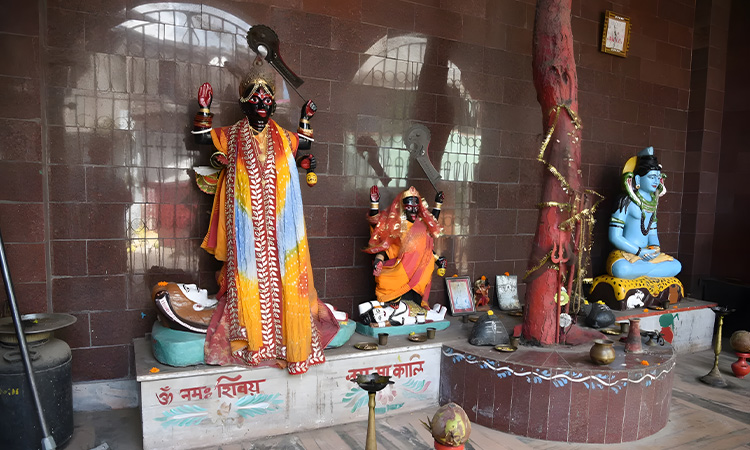
In the packed neighborhood of Tangra, India’s only Chinatown, there stands a mandir that embodies a confluence of beliefs. The Chinese Kali Mandir was built by the diaspora community of China living in Kolkata to honor the Goddess.
Local legend says that around six decades ago, when a Chinese boy fell gravely ill, his parents brought him to a humble altar of two black stones worshipped as Goddess Kali by local Bengalis. After offering prayers, the boy recovered, and in gratitude, his parents built a temple on the spot. Now, this Kali Mandir in Kolkata serves as a melting pot of diverse influences. Here, you can find Chinese-style frescoes of Hindu deities as well as Chinese dishes served as bhog.
Timings: 5 am–2 pm & 5–10:30 pm
5. Dakat Kali Bari
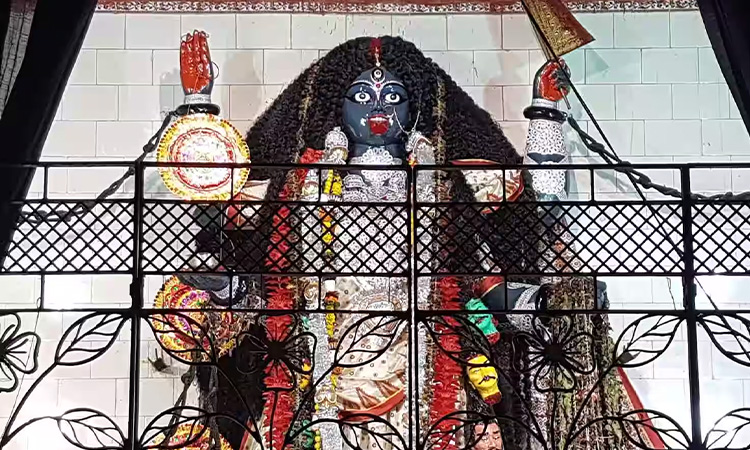
You might have heard of animal sacrifices at Kali temples, but this Maa Kali temple in Kolkata was a place of human sacrifices. Built in 1891, the temple was a home to dacoits led by Manohar Bagdi, or Manor Dakat (dacoit). It is said that whenever the group was about to commit a robbery, they would worship the Goddess Kali to achieve success in their endeavors, and that worship involved performing a human sacrifice.
Today, the mandir stands in the posh area of South Kolkata and boasts an evocative structure that would transport anyone to that fearful era of dacoits.
Timings: 5 am–9:30 pm
6. Thanthania Kali Bari
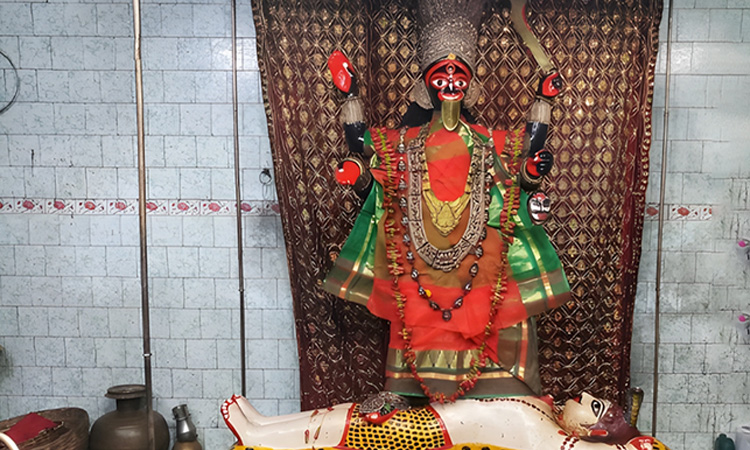
‘Jagroto’ is one word that you would constantly come across while mandir-hopping in Kolkata. Though it literally means ‘awake’ or ‘conscious,’ in the context of mandirs it signifies a place where the deity’s divine presence is believed to be especially potent. And Thanthania Kali Bari is one such revered temple, where devotees believe Maa Kali’s blessings are at their strongest.
Located in the heart of Kolkata, this Kali Mata Mandir in Kolkata was frequented by the likes of Shri Ramakrishna Paramhansa. It is said that at first, a bell was installed here to warn the nearby villages of coming dacoits. Later, a tantric brahmachari consecrated the site by installing an idol of Kali, paving the way for the temple’s construction. The name ‘Thanthania’ is inspired by the sound of the bell.
Timings: 7 am–1 pm & 3–10 pm
7. Boro Maa Kali Temple
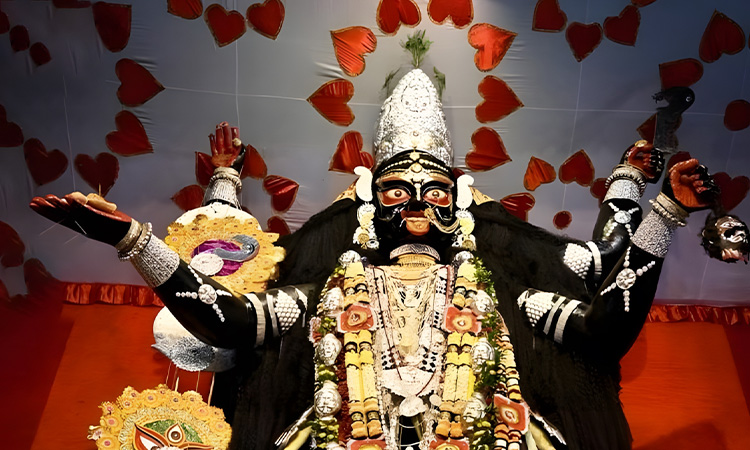
This Kali Mata Temple in Kolkata displays a colossal idol of Maa Kali, about 22 feet in height. The idol is said to hold miraculous powers, highly revered by her devotees, for fulfilling all desires and wishes. Those who believe in her powers always say “Boro Maa kauke feray na” (Boro Maa doesn’t turn anyone away).
The temple’s origins trace back to 1923, when a young Bhavesh Chakraborty, after visiting Nabadwip and marveling at its magnificent idols, dreamt of creating something similar in his hometown. Returning to Naihati, he built a towering 22-foot idol of Goddess Kali, which over time came to be lovingly known as ‘Boro Maa’.
Timings: 8 am–1 pm & 4–8 pm
8. Firingi Kalibari

The Firingi Kalibari is one of the oldest Kali temples in Kolkata, said to have been associated with the famous Kabial and devotee of Kali, Anthony Firingi, who is rumoured to have helped build the modern structure.
However, a plaque on the temple dates the temple back to approximately 1498 AD, much before the time of Anthony Firangi, even before the Europeans arrived in India. This temple was built by Srimanta Dom, a person belonging to the lower caste, who used to do the pooja himself and treat people suffering from smallpox. Today, the main deity of the temple is Maa Siddheswari.
Timings: 7 am–12:15 pm & 4:30–8 pm
9. Sri Sri Nistarini Devi Kali Mandir
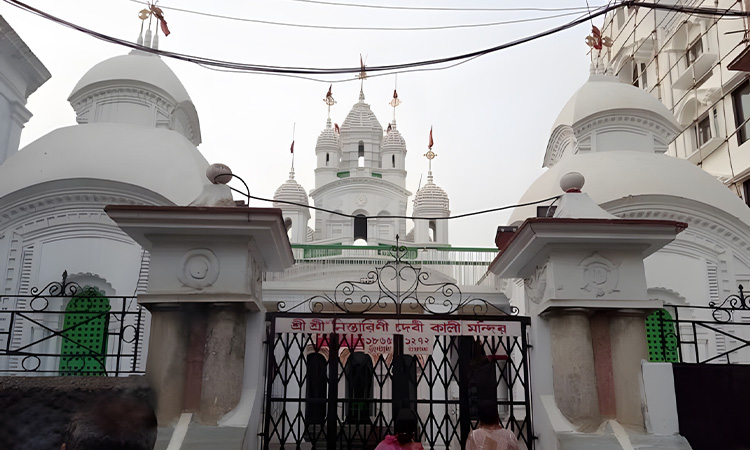
Established in 1865, the Nistarini Devi Kali Mandir was made in the image of the Dakshineshwar Kali Mandir, showcasing a Nava-ratna style of Bengali architecture. As soon as you step inside the temple complex, you’ll find yourself marveling at the beauty of the structure. The courtyard is flanked by two archana Shiv Mandirs, and in the sanctum sanctorum, an elaborate murti of Maa Kali is placed. It is said that 51 days of darshan at the Nistarini Devi Kali Mandir will make all your wishes come true.
Timings: 7–10 am & 6–9 pm
10. Sri Sri Karunamoyee Kali Mandir
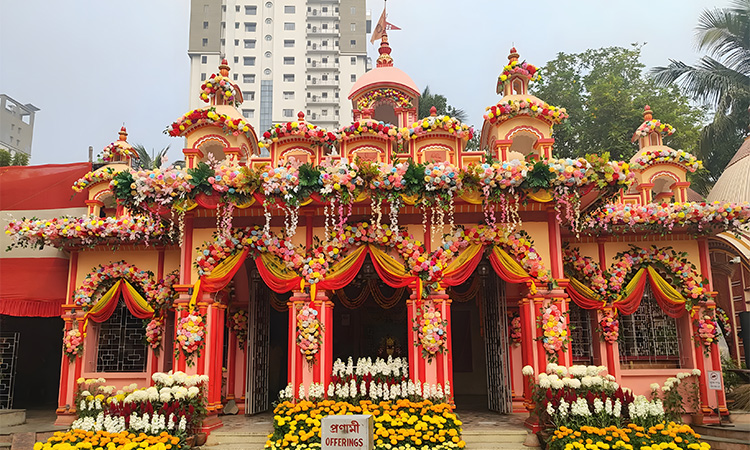
This small but peaceful temple is the perfect spot to immerse yourself in devotion. Built around 70 years ago, this temple is a relatively young yet powerful presence in Kolkata’s spiritual landscape. Visitors can offer prayers, admire its vibrant domed architecture, and stroll through its neatly kept gardens for a moment of quiet reflection.
Timings: 6 am–12:30 pm & 4–9 pm
To Conclude
And there you have it, a complete guide to some of the finest Kali Mandirs in Kolkata, each offering a unique spiritual experience. Together, they capture the very soul of the city, from its centuries-old legends to its living traditions. For the best experience, dress in modest traditional attire and plan your visit in the morning hours, when the atmosphere is calm and the crowds are yet to arrive.
Frequently Asked Questions (FAQs):
Q. Which is the main Kali Mandir in Kolkata?
A. Kalighat Kali Temple is considered the most important Kali temple in Kolkata.
Q. Where is Kali Puja famous in Kolkata?
A. Kali Puja is celebrated grandly across the city, especially at Kalighat and Dakshineswar temples.
Q. Why is Kalighat Temple famous?
A. It’s one of the 51 Shakti Peeths, where the toes of Goddess Sati are believed to have fallen.
Q. Which is better, Kalighat or Dakshineswar?
A. Both are significant. Kalighat is centrally located and steeped in Shakti Peeth lore, while Dakshineswar offers a larger riverside complex and historical charm.
Q. Which day is best to visit Kali temple?
A. Tuesdays and Saturdays are considered most auspicious for Maa Kali worship.
Q. What is the dress code for Kalighat Temple?
A. Modest, preferably traditional attire is recommended.
Q. How to pray to Maa Kali at home?
A. Offer flowers, incense, and sweets, light a lamp, and chant Maa Kali mantras with devotion.
Also Read: Best Places to Visit in Meghalaya | Haunted Places In Delhi

